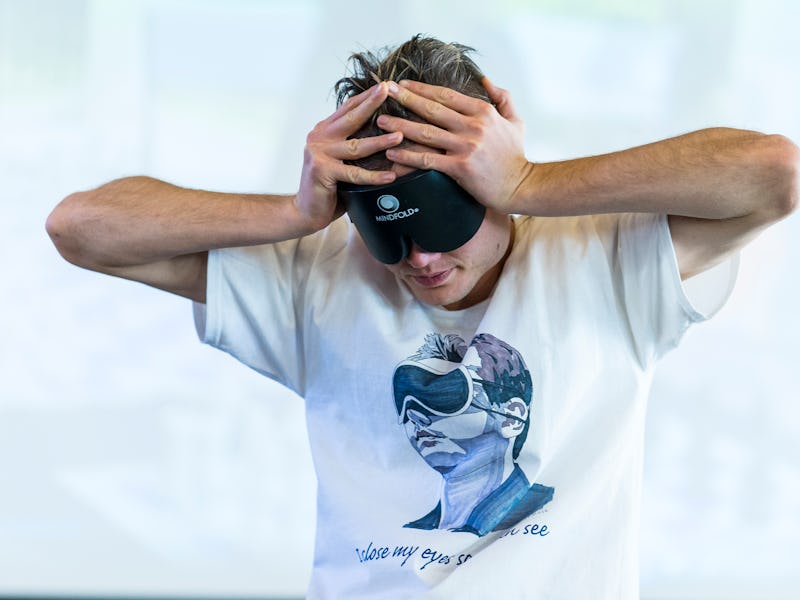Blindfold Chess King Reveals His Memory Tricks
How to play 48 chess games at once without looking at the board.

Timur Gareyev was just moves into a world record 48-board simultaneous blindfold chess exhibition in Las Vegas when he decided to change tactics.
“I was like, OK, I’m just going to try to go with the flow and let the memory do its work the way it normally does,” Gareyev tells Inverse.
The then-28-year-old grandmaster had spent weeks studying a technique known as a memory palace. In his case, it involved translating chess moves into images and placing those images in 48 mental rooms: He would picture Princess Diana for an opening of D4; Elvis for an opening of E4; and add or alter characters in rooms based on what happened on each board. But on the morning of the exhibition last December, Gareyev decided this approach was too complicated: Instead, he was going to wing it.
Nineteen hours later, Gareyev finished his last game, winning 80 percent against fair competition (averaging 1700 ELO) — a feat that was later certified as a Guinness World Record for the most games in simultaneous blindfold chess.
So how did he do it? Gareyev, who calls himself the Blindfold King, says the key was reaching a relaxed but focused mental state and trusting his brain to figure out the hard stuff.
It’s for this reason, in part, that he pedaled an exercise bike throughout the exhibition.
“You want to catch the rhythm where there’s a flow and you don’t get stuck,” he says. “You just keep going. It’s the same sensation I have when I start spinning the pedals.”
Gareyev plays 48 people at once, blindfolded, while biking.
Gareyev’s main strategy, beyond staying loose, was finding ways to make each game stand out in his mind. “I try to create a story,” he says. That way when he got back to a board, sometimes approaching an hour since his last move, his brain had something to latch onto.
He did this with a combination of symbols from memory palace training; spontaneous, abstract imagery; and freeform associations tied to board number, player name, and his mental image of each opponent.
“If it’s board number 13, maybe I’ll play something risky because it sounds unlucky. Or board 21, that’s like blackjack so it has to be some kind of gamble,” he says. “If board 14 is a little boy and he plays Scandinavian, then that’s a theme. I capture a piece, it could be like a burst or a diagonal shape or I could see water flowing based on the theme.”
Another trick to making games stand out was making unusual moves. On board 12, “I played this crazy gambit line where I’m giving up a pawn for nothing,” he says. On board 1, “I pushed this pawn here to H4 … that’s a crazy game,” he says, referring to a highly uncommon third move he made as white.
Sometimes the King forgot stuff.
On board 18, facing one of the least experienced players at the exhibition, he got off track when she didn’t move her knight away from an attacking pawn: By the time he got back to that board, he assumed her knight must be somewhere else — and then for a while he couldn’t figure out what was happening in that game. “I literally blanked and then I was like what happens here?” he says. “I couldn’t figure out [what was happening] all the way until the middle game when I lost a piece.”
For the most part, over the course of around 1,400 moves, he remembered. (See all the games at Chess News and analysis at Chess.com and Chess Life.)
Gareyev (center) stands with event organizer Jennifer Vallens from Off da Rook Entertainment.
If Gareyev makes it sound easy, history shows it isn’t. Back in 1900, Harry Pillsbury made headlines for playing 20 games at the same time blindfolded. After a series of escalating records, chess legend Miguel Najdorf set the record with 45 games in 1947. That record lasted until Marc Lang did 46 in 2011. And then Gareyev came in with 48.
Although the exact terms of this competition are hard to define — with variation in the quality of opponents, win rates, and match circumstances — there’s no question that the feats are escalating. And Gareyev isn’t done yet.
“The next event, I’ll play 55 games blindfolded,” he says. And why stop there? “The ultimate challenge would be 64 boards,” he says, one for every square on the chessboard.
Gareyev, who emigrated from Uzbekistan to the U.S. at age 17, has won accolades in traditional chess too — among them, placing third at the 2013 U.S. Chess Championship. But the grandmaster, who also enjoys sky-diving, hiking, and motorcycling, says he is increasingly drawn to special challenges like blindfold simuls.
He tells Inverse: “Just regular chess is boring to me.”